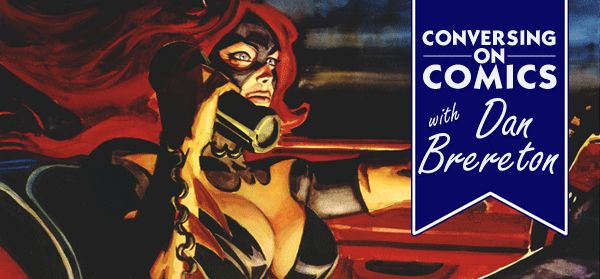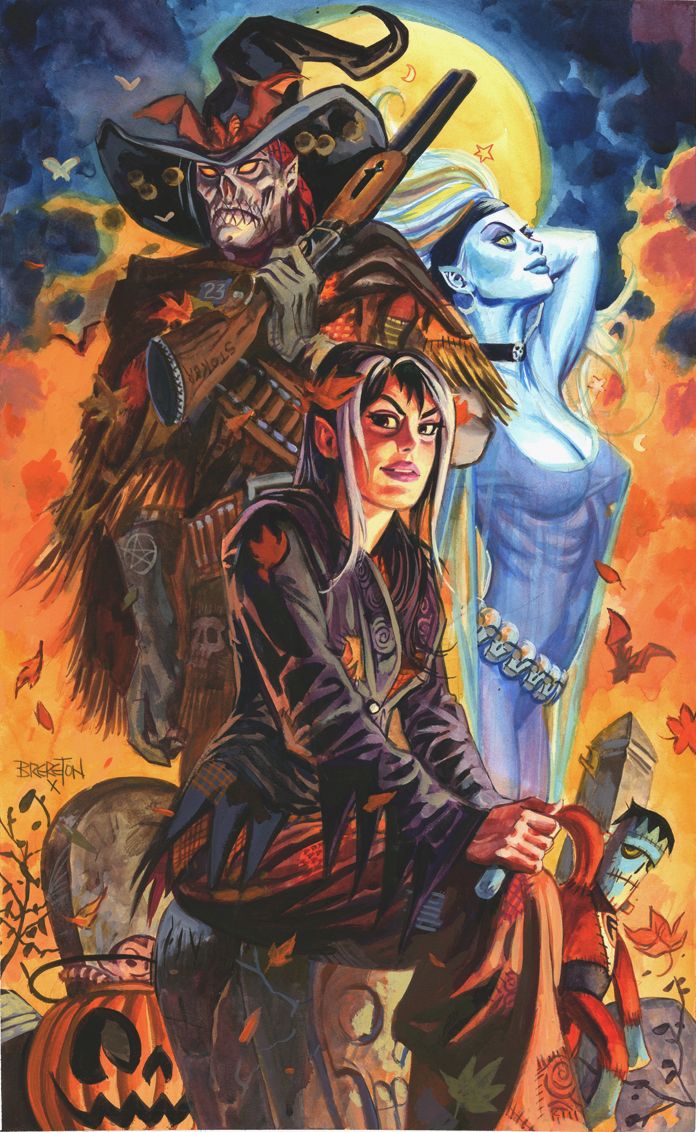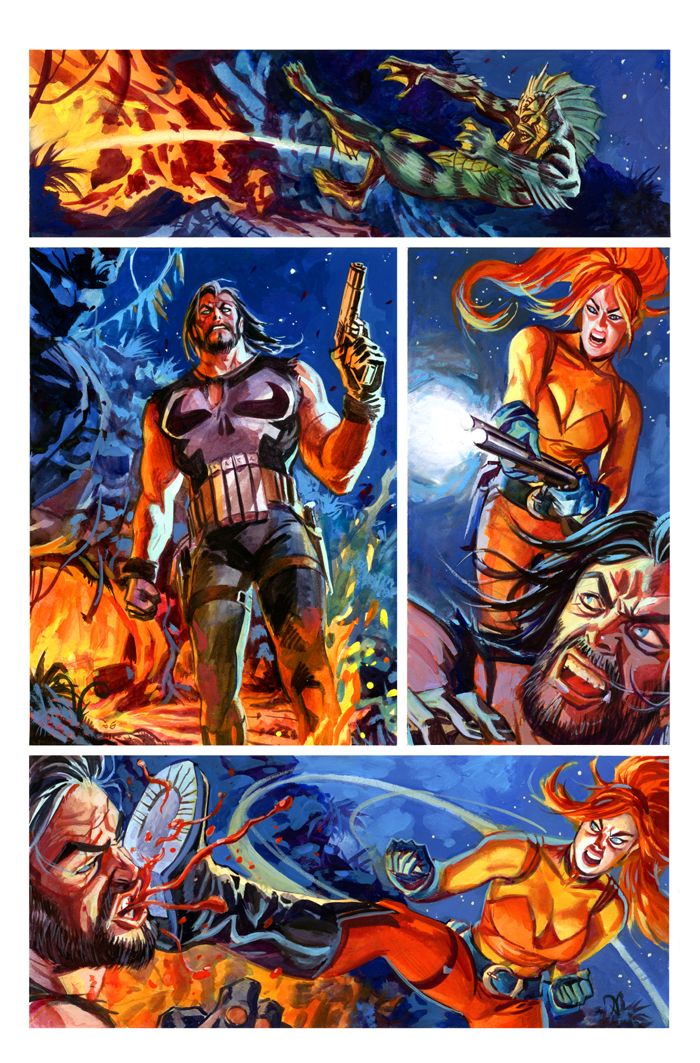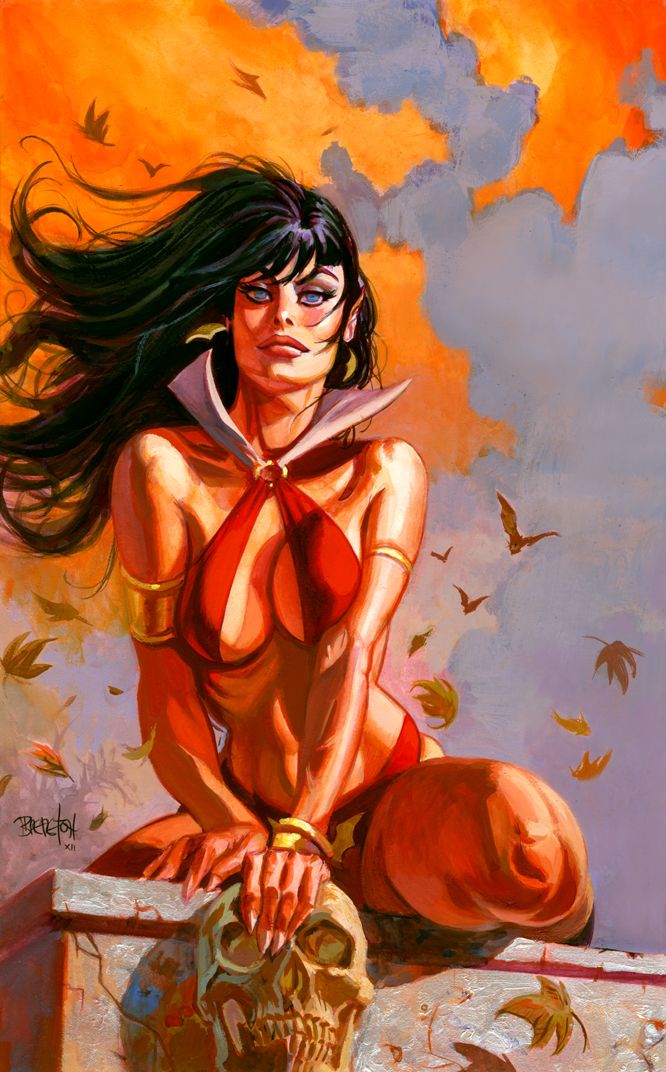Dan Brereton entered the industry in the late 1980s and, alongside Alex Ross and a select few others, ushered in what he playfully calls the Golden Age of Painted Comics, one in which not only covers but interior pages were fully painted. If we were to compare that era to classic Hollywood, Alex Ross would be Cary Grant while Brereton would be Vincent Price. And he wouldn't have it any other way.
Brereton's lush, horror-tinged art led him to quickly jump from the independents to major work at Marvel and DC, where he made a name for himself with series like The Psycho and Legends of the World's Finest, earning him the Russ Manning Award. In 1997, he teamed with Howard Chaykin for a romping Elseworlds story titled Thrillkiller, which prompted a sequel, and then put him on his way to his own creations -- the Nocturnals.
In the years since, he's balanced between creator-owned and work-for-hire, both in the United States and in Europe. I reached out to Brereton to talk about the 20th anniversary of his creator-owned Nocturnals, as well as his dalliances with work at DC, Marvel and elsewhere, and what his plans are for 2014 and beyond. He fills us in on two exciting new creator-owned projects, as well as a return to Nocturnals and a story for DC's digital-first comics.
Chris Arrant: What are you working on today?
Dan Brereton: This evening I'm painting a page from part one of my Legends of the Dark Knight arc , entitled "Six Fingers." I wrote it last year. It's fours parts, and will debut on DC Digital First. I'm very excited about this one: It's a return to Batman for me, over a dozen years in the making, and even longer since my work on Legends of the Dark Knight itself. You can download that effort on the DC site, Legends of the Dark Knight #114. This new one is fully painted. The first chapter will debut later in the year. It features characters like the Joker and Mad Hatter, but it's more of a scary horror trip Batman is caught up in. Very fish out of water, but also very much Batman as the Dark Knight Detective we expect him to be.
2013 was an interesting year for you: You wrote Vampirella: The Red Room, did some covers for Marvel, IDW and Dark Horse, and put out a new art book titled Sorceress. Where do you see yourself going in 2014?
I'm about to embark on a project which will involve developing an IP for Topps, a thing I'd love to discuss more if I could. It started with my desire to create a new card set property, but it's kind of mushroomed into something a bit more ambitious for them. After my work on the Batman arc is complete, I'll be throwing myself into creator-owned work, and probably some crowd-funding to help support it. Ive put off a return to my own creations for a bit longer than I'm happy with -- so I'm really looking forward to executing the plans in 2014 I laid out in the previous year. I've been looking forward to 2014 for a very good reason ...
2014 is the 20th anniversary of your most famous creation, Nocturnals. Do you have any plans to ring in the occasion?
Yes! Most definitely. This year will be full of pleasant surprises for the readers, for fans of the Nocturnals, and for fans of comics, art, story, who are looking for something to come along and sweep them up.
Could we at some point see you doing more Nocturnals comics?
Yes! That's a big part of the plan for this year. One priority is a special issue to commemorate 20 years since its debut in December of '94 -- a special introducing them to new readers, and a homecoming for longtime fans. Prior to this, we'll see the release of Nocturnals Legend, a 150-page, 9-by-12 compendium of their saga as written and compiled by the characters, themselves. I'm also assembling a limited-edition 11-by-17 portfolio as well.
It's time for me to focus on what I do best, and the world I created for my characters 23 years ago. They are as vital and timeless now for me as they ever were .
Why do you think you were drawn to horror and monsters so early and so dominantly in your professional career?
One of earliest memories of drawing monsters is from kindergarten. Our teacher asked us one afternoon what we wanted to do with the hour we had left in class and I yelled out, "Let's draw monsters!" Teacher agreed and that was one of the greatest hours of my life in school. For that period of time I was the expert of monster drawing in my class, and the great feeling from that experience instilled an importance to accompany the pure fun of drawing -- so monsters are tied very directly to my art. The creative process is tied to it. Your imagination is where monsters live. So to my mind, anyway, monsters are the purest product of our imaginations, whether they be good or bad or just plain wild. That idea never ceases to inspire me and find it's way into my work. I don't even think of monsters as a genre anymore. It's to big a word to contain -- monsters are in almost every story in one form or another -- and that certainly holds true in superhero stories.
One of the earliest works people came to know you by is Batman: Thrillkiller with Howard Chaykin. Unlike some of your contemporaries, you've never really jumped into superheroes 100 percent, despite many opportunities. You do it here and there, but not making it the be-all, end-all. Can you tell us about your thoughts on superheroes and the work-for-hire industry that surrounds it for the most part?
I'm fine with the work-made-for-hire environment, really. I've worked in it for 25 years without a whole lot of complaint. Superheroes seem to thrive in that environment, and not as much outside of it. It isn't only comics fans who practically worship established heroes: Look at the success of the Marvel film franchise. I have had a hankering to create a super-universe for as long as I can remember. I got to dabble in that early on with The Psycho -- anyone who wants a to see a Brereton super-verse, check out the parade of costumed super-beings in that graphic novel. Part of the reason there are so many characters appearing there is because we were establishing a world we wanted to feel real and established -- and because DC wanted to make it a monthly comic. If I could make a super-verse fly, I'd love that. Established companies have the resources to maintain the cross-continuity of many titles, to feed the hunger of the reader who craves more of that world. This is what drew me to the Marvel Universe as a kid in the '70s: an alternate universe you saw for a quarter per peek. I am perfectly happy working superheroes. I think I have an aptitude for them, which has not been utilized to full potential, not to my satisfaction.
For instance, I would love to do something involving Jack Kirby's Fourth World characters. When I come to the table with superhero pitches, invariably it's the ones that involve something with a monster or supernatural bent that are chosen by editors. I think it's because they enjoy seeing me do what they consider to be my best feature. And to be honest, I probably gravitate toward them note myself. But I'd you have ever read The Last Battle, the graphic novel I did with Tito Faraci, you could say I like a good departure now and then, too. I'm not tied to any one genre, except perhaps for crime fiction. I prefer to look at superhero stories as a form of crime fiction with a fantastic pulp sensibility woven into them. Steven Grant and I use to talk about doing Conan as crime fiction. Crime, noir, mystery, almost always find themselves into my creator work some way or another. The current Batman project is a perfect melding of supernatural, crime, mystery, which is exactly what Nocturnals is, as well.
You came onto the comics scene in the early '90s and bore witness as a fan and a creator as painted comics went from being a rare commodity to being more and more common, with Alex Ross, Esad Ribic and yourself all leading the way. What do you think of the acceptance of it, and the modernization of printing and coloring technology to allow it?
Technology certainly caught up with what painters are able to do, on paper and of course digitally, but it sure took a long time! I think during what I'll call, just for fun, the Golden Age of Painted Comics -- the '90s -- we could've really used it. It just wasn't there. Now that we have it. Painted comics are not nearly as prevalent now. Some ways it's a detriment to my profession that I'm not digital artist at least that's how it feels sometimes. By the same token, because I paint with an actual brush with actual paint on actual paper 00 I'm overladen with work. Collectors of the work appreciate the fact they can have an original piece of artwork to own, so my commission list is through the roof! I think that you have a variety with the option of a fully painted comics , especially with certain stories, I think, which benefit from it.
It seems like money has been an obstacle with a lot of creative projects since the '90s and the huge drop-off in sales which occurred then. So many stories I've written and wanted to illustrate have had to be shelved. This makes me excited for the success of crowdfunding. A veteran creator can basically support himself and his family while working on a project that a specific number of people have already supported, and to the benefit of many more people who will see in the direct market. It makes me excited for the future of fully painted comic books stories, stories in general , which need to come out from many many more creators than there's room for in the current direct market.
Last year you did a short with Len Wein for Bongo Comics' Treehouse of Terror #19. It was a really fun story, and great to see you working with Len.
Thanks!
What was that experience like?
It was great! I love Bongo. I asked my longtime pal and editor, Bill Morrison, for Len Wein, and lo! Len appeared! Unfortunately, we lost the involvement of Bill as our shepherd partway through the process, as he moved up the ladder in the company, but everyone at Bongo is great. Any time I start a Simpsons story I'm always nervous because I'm fighting my style in favor of doing theirs. But by the time the art is finished, I'm ready to dive into any Bongo story after that. I had lamented to Bill for many years the fact Bongo had never done a Lovecraft spoof. It was pretty amazing to break new ground there. Bill had wanted to do an all-Lovecraft Treehouse of Terror issue that year, and I was going to write the other two stories and artwork for all three -- and after Bill was moved up the ladder, it turned out, literally, to be too good to be true. Len and I didn't collaborate much, as we has both wanted to -- an email mix- up, I think. Unfortunate, but on his own he penned a very funny story with ghastly moments. I was free to put my stamp on the visuals, which was like being set loose in an amusement park.
I wanted to also ask you about Vampirella: The Red Room, and coming into your own writing more. This isn't your first time writing for another artist, but this miniseries really showed off that ability. Vampirella seems like a really apt character for you, and it's not your first time, but how was it?
Thanks, Chris, I appreciate that. I'm a fan of Vampirella; her character has always had so much potential. There's an argument to be made that her potential has yet to be realized . While Vampi was still at Harris Comics, I wrote a Halloween special called "Dungeon Eyes," drawn by my friend John Heebink, a talent whose work I love. I was really happy with the way that story came out. If you can go look it up it's a fun one , and John is such a great draftsman. So when I found out Vampirella had been acquired by Dynamite Comics, I was all over Nick to do something. I had written two separate, single-issue Red Sonja stories for them and I was chomping at the bit to do more. With Vampirella: The Red Room I was again working with an artist, but the major differences this time was I didn't choose him and I didn't have any idea who would be drawing it until I was well into writing the thing. I knew there was a chance I wouldn't connect with the art, so I focused everything on what was happening in the story itself. I tend to get lost in there, which is, of course, the appeal of writing. And the more I got my head into the story, the more and more I felt should be doing the art myself. I pursued it with them, arguing sales of the miniseries would be much higher if I were also doing the art, but was basically told they couldn't afford me. I knew exactly how that story needed to look- to the point where I did a dozen concept drawings for characters and creatures appearing in the story, due to a persistent vision of how it looked in the pages of my head. And ultimately, as talented as he is, and as good a guy as he is, it wasn't a perfect fit for the artist. It was really my story to tell from beginning to end.
I know full well why it all happened the way it did -- no one need explain the business side of thing to me. The miniseries was product. It wasn't going to impact the monthly series, they wanted another comic with her face and logo -- and costume -- out there on the shelves. So the investment was small for them. In the end, it was another opportunity for me to derive joy from telling stories. I don't care if it's part of continuity or if it's hammering out the history of a character, small or large, if it's a big project or not, my heart will be in it. I'm sure most writers feel this way, but I can't help but think as an artist- who must immerse himself into every picture he draws or paints -- that tendency must lend itself to storytelling in any form. It's an asset to writing and could never be a detriment. When all is said and done, I would write any of those characters again for the chance to tell more of their stories.
Is writing, especially writing for another artist, something you're looking to do more of in 2014?
Yes, particularly when I come across an artist whom I like personally and whose work inspires me. I always want to work with those people. I want to write for them, or pair them with an existing something I feel is perfect for what they do. It's very important for an artist to be engaged in the story and feel like that story was almost written for him if not written for them. I have a project called Autumn I want to see happen with a very talented artist from Spain who is a sweet and intelligent fella , fantastically talented -- Nacho Fernandez -- and we are in the process of setting it up. I have any number of projects and artists of love to work with, so that's a constant for me.
Outside of comics you've done things like concept art for movies, art for TV shows, album covers, and even some art for a Wild West theme park. Any illustration projects recently that people may not know about?
I can't really offer much of an answer there at present, but the work I'll soon do for Topps on this IP is something I hope sees the light before too long. It's an exciting concept and I'm very enthusiastic about. Sorry, I know that's a tease. Check out Phantomcanvas.com for prints and gallery wrapped canvas editions of my work. It's a company I helped found and we are really happy with the response from happy customers so far since we started in July. We offer prints for any budget, which is nice. This is the year I'll be concentrating most on bringing the Nocturnals back to the comic shop shelves and into the hangs of supporters and backers, fans and readers. I couldn't be more excited about this.







